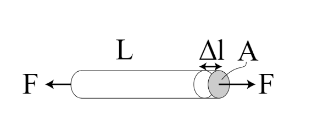
Longitudinal strain is calculated using the formula
E. Change in length/ Original length
F. Original length/ Change in length
G. Original length$ \times $ Change in length
H. Original length$ - $ Change in length
Answer
564.6k+ views
Hint: Longitudinal strain is caused due to longitudinal stress and is denoted by the Greek letter . When a deforming force or external force is applied on an object, its intermolecular or interatomic distances vary.
Complete Step by step answer: We know that all solids are elastic by nature. Atoms or molecules shall constitute them. Each atom or molecule is surrounded by neighbouring atoms or molecules which are bonded together by the intermolecular forces and shall stay in equilibrium. When a deforming force or an external force is applied on the object, a restoring force will be generated to gain back the equilibrium, thus regaining original size and shape.
When an object is subjected to a deforming force, the restoring force will be generated to oppose the deforming force and get back t0 its original shape and size.

Consider a cylinder as shown in the figure with length $L$ and cross-sectional area $A$ of the cylinder. When a force $F$ is applied such that it is perpendicular to the cross-sectional area, there will be a change in its length. The length will increase from $L$ to $L + \Delta L$ where $\Delta L$ is the change in length. Thus, the change in dimension to the original dimension is defined as strain. It gives the amount of stress an object is experiencing.
Thus the longitudinal strain can be defined as the ratio between the change in length $\Delta L$ and original length $L$.
$ \Rightarrow \varepsilon = \dfrac{{\Delta L}}{L}$ That is, Longitudinal strain=change in length/original length.
$\therefore $ Option A is correct.
Note: Students can commit mistakes by getting confused between the formulas of stress and strain. It can be remembered as stress expresses internal forces that every particle exert on each other whereas strain is the measure of the deformation of the material.
Complete Step by step answer: We know that all solids are elastic by nature. Atoms or molecules shall constitute them. Each atom or molecule is surrounded by neighbouring atoms or molecules which are bonded together by the intermolecular forces and shall stay in equilibrium. When a deforming force or an external force is applied on the object, a restoring force will be generated to gain back the equilibrium, thus regaining original size and shape.
When an object is subjected to a deforming force, the restoring force will be generated to oppose the deforming force and get back t0 its original shape and size.

Consider a cylinder as shown in the figure with length $L$ and cross-sectional area $A$ of the cylinder. When a force $F$ is applied such that it is perpendicular to the cross-sectional area, there will be a change in its length. The length will increase from $L$ to $L + \Delta L$ where $\Delta L$ is the change in length. Thus, the change in dimension to the original dimension is defined as strain. It gives the amount of stress an object is experiencing.
Thus the longitudinal strain can be defined as the ratio between the change in length $\Delta L$ and original length $L$.
$ \Rightarrow \varepsilon = \dfrac{{\Delta L}}{L}$ That is, Longitudinal strain=change in length/original length.
$\therefore $ Option A is correct.
Note: Students can commit mistakes by getting confused between the formulas of stress and strain. It can be remembered as stress expresses internal forces that every particle exert on each other whereas strain is the measure of the deformation of the material.
Recently Updated Pages
Why are manures considered better than fertilizers class 11 biology CBSE

Find the coordinates of the midpoint of the line segment class 11 maths CBSE

Distinguish between static friction limiting friction class 11 physics CBSE

The Chairman of the constituent Assembly was A Jawaharlal class 11 social science CBSE

The first National Commission on Labour NCL submitted class 11 social science CBSE

Number of all subshell of n + l 7 is A 4 B 5 C 6 D class 11 chemistry CBSE

Trending doubts
What is meant by exothermic and endothermic reactions class 11 chemistry CBSE

10 examples of friction in our daily life

One Metric ton is equal to kg A 10000 B 1000 C 100 class 11 physics CBSE

1 Quintal is equal to a 110 kg b 10 kg c 100kg d 1000 class 11 physics CBSE

Difference Between Prokaryotic Cells and Eukaryotic Cells

What are Quantum numbers Explain the quantum number class 11 chemistry CBSE




